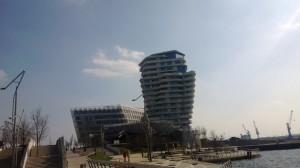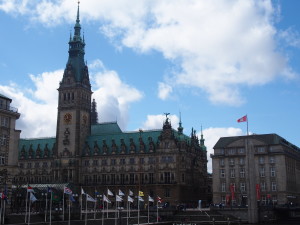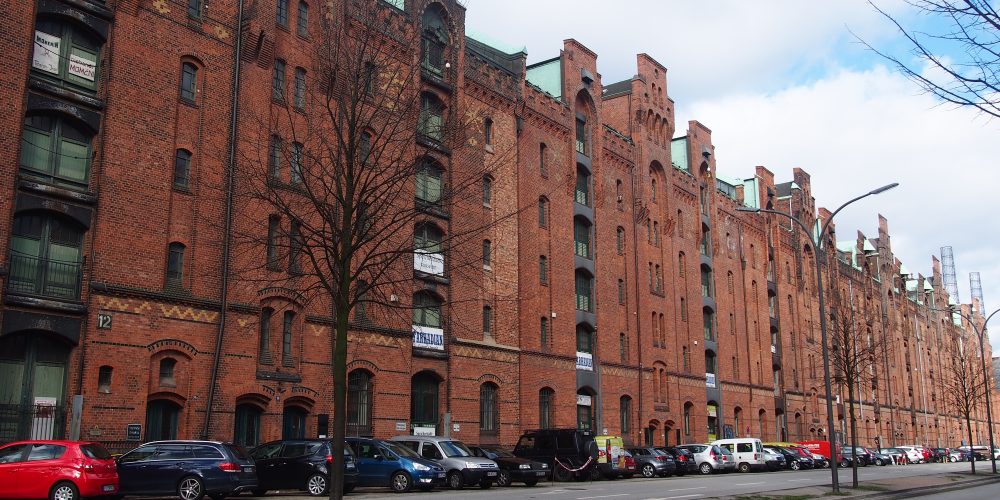“Are you sure you’ll get on with a Spanish-speaking tour guide? After all, Brazilians usually speak Portuguese.” – “Yes, we are. Many of the group also speak German.” – ? Oh right, all right. After some confusion about the meeting point, we finally found each other at the central station and started our time together with a trip towards the Speicherstadt and HafenCity. The group had already done a tour of Hamburg two days earlier and had therefore picked out special spots today. Speicherstadt, HafenCity, Ballinstadt, the harbor and the shopping area. No sooner said than done. Our bus driver Werner actually did everything by himself. I just sat next to him and talked in Spanish, which sometimes faltered into German or French, but the group and the tour guide understood me – at least that was the general consensus.
 The 19th century Speicherstadt was particularly beautiful in the sunshine and, thanks to the low tide, we could even see the oak piles on which the entire complex was built. What we saw in HafenCity was in stark contrast. Ultra-modern buildings in completely different styles, different materials and for different uses. While the old warehouses, since the abolition of the free port, now house museums and offices, HafenCity is a completely new district with schools, shopping and work facilities. Of course, there will also be hotels and apartments.
The 19th century Speicherstadt was particularly beautiful in the sunshine and, thanks to the low tide, we could even see the oak piles on which the entire complex was built. What we saw in HafenCity was in stark contrast. Ultra-modern buildings in completely different styles, different materials and for different uses. While the old warehouses, since the abolition of the free port, now house museums and offices, HafenCity is a completely new district with schools, shopping and work facilities. Of course, there will also be hotels and apartments.
 We then drove past the Cruise Terminal to the south bank of the Elbe, where we were able to view the old emigrant accommodation and its history in Ballinstadt. After a short stop to take photos and drink champagne at the southern end of the Old Elbe Tunnel (with its magnificent, sunlit city panorama), we drove over the Köhlbrand Bridge, the highest bridge in Hamburg, and through the new Elbe Tunnel, 23 meters below the Elbe, towards the city centre. In the west of Hamburg, we were able to admire some magnificent 18th and 19th century city mansions, as well as the Altona Town Hall, which used to be Altona’s railroad station building. After passing the St. Pauli fish market and the Bernhard Nocht Institute, we went to Mönckebergstraße, where my Brazilian guests bought suitcases to take their purchases back to Brazil. Throughout the conversation, it turned out that some of them actually spoke good German. What else can you speak when you come from a place in Brazil called “Blumenau”?
We then drove past the Cruise Terminal to the south bank of the Elbe, where we were able to view the old emigrant accommodation and its history in Ballinstadt. After a short stop to take photos and drink champagne at the southern end of the Old Elbe Tunnel (with its magnificent, sunlit city panorama), we drove over the Köhlbrand Bridge, the highest bridge in Hamburg, and through the new Elbe Tunnel, 23 meters below the Elbe, towards the city centre. In the west of Hamburg, we were able to admire some magnificent 18th and 19th century city mansions, as well as the Altona Town Hall, which used to be Altona’s railroad station building. After passing the St. Pauli fish market and the Bernhard Nocht Institute, we went to Mönckebergstraße, where my Brazilian guests bought suitcases to take their purchases back to Brazil. Throughout the conversation, it turned out that some of them actually spoke good German. What else can you speak when you come from a place in Brazil called “Blumenau”?

